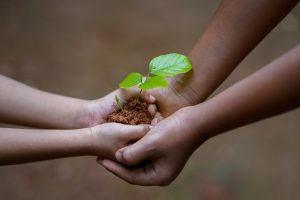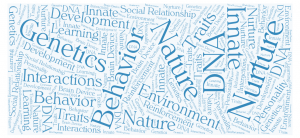Author: Andresa DeSouza, Ph.D., BCBA-D, LBA
I just watched “Three Identical Strangers,” a documentary directed by Tim Wardle which tells the story of the accidental reunion of three identical triplets at the age of 19. The triplets were given up for adoption at 6 months of age to three different families. During the adoption process, none of the families were informed that their soon-to-be adopted child was a triplet of two other living-children. Their reunion became a big sensation in the early ’80s with the three young men appearing on the first-page of newspapers, magazines, and being invited to several talk-shows. Everyone, including the triplets, were shocked at how many traits and interests they all had in common. The first part of the documentary brought up the influence of genetics in the development of behavioral traits and interests.
 The question of Nature vs Nurture has been central to psychological science and the study of human behavior (McLeod, 2018). At some point in our lives, we have probably seen individuals from the same family with very similar behaviors. We can then ask: how much of that is genetics and how much was shaped by the individuals’ environment? Can patterns of behavior be influenced by one’s DNA? What about language and communication? Are these defined by our genetics? Well, some people believe they are!
The question of Nature vs Nurture has been central to psychological science and the study of human behavior (McLeod, 2018). At some point in our lives, we have probably seen individuals from the same family with very similar behaviors. We can then ask: how much of that is genetics and how much was shaped by the individuals’ environment? Can patterns of behavior be influenced by one’s DNA? What about language and communication? Are these defined by our genetics? Well, some people believe they are!
The Nativist Theory vs The Behavioral Theory
The nativist theory defends that all children are born with the ability to develop language skills and to organize them within the grammatical rules of their native language. In other words, language is innate to the individuals and part of the human experience (Litchfield & Lambert, 2011). The most famous nativist is Noah Chomsky, who suggested that children are born with a language acquisition device (LAD), hard-wired in their brain which enables the acquisition of language and the use of grammar. Furthermore:
“Nativist theories support this notion and believe that if a native language is not learned before this age, it can never be learned in a normal, natural manner or to a fully functional state” (Litchfield & Lambert, 2011).
According to the nativist point-of-view, every child has an innate capability to develop language within a developmental window regardless of their environment and other developmental conditions. Watch the video below for a brief and general overview of Chomsky’s conceptualization of language development.
The behavior analytical view of language (a.k.a., verbal behavior) approaches the development of these behaviors from the same perspective as any non-verbal behaviors: They are shaped and maintained by the variables in the environment and the contingencies of reinforcement available in one’s context. These involve appropriate models, incentives for engaging in language, direct teaching of specific communication skills, and positive consequences for engaging in these behaviors. In his book Verbal Behavior, Skinner (1957) breaks down the different types of verbal behavior and described the variables which evoke and maintain these behaviors.
What Has Research Shown Us?
Children start acquiring communication and language skills at a very young age. It is not easy to pinpoint when each new language response is acquired. The reason for that is not because of the existence of an innate, internal brain device but due to the fact that most of a child’s early learning occurs in informal interactions with their caregivers and other people around them (read: Let’s Talk Baby! and Let’s Give Them Something to Talk About! for a review of the importance of parent interactions with their infants). During these interactions, language is modeled and the child’s attempts of reproducing the model are shaped and reinforced throughout these interactions.
 Years of behavior analytical research involving verbal behavior interventions for children with autism and language delays have shown that language and communication skills can be acquired as a result of appropriate environmental conditions that foster and support the development of these behavior repertoires (DeSouza et al., 2017). In other words, the conditions present in the child’s environment as well as the consequences for the child’s verbal behavior, matter. As the child grows, their verbal repertoire is also shaped by the people around them including family, friends, and peers. Consider the case of how individuals from the same family might have different accents or even dialects if they grow up in different parts of the country (e.g., New Orleans vs New York) or come from different cultural backgrounds. For example, if you live in the West Coast you might call a carbonated drink a “soda” while your cousin from Louisiana calls it “coke” and your grandma, who lived her entire life in Montana, calls it “pop” (American English Dialects Map 2018).
Years of behavior analytical research involving verbal behavior interventions for children with autism and language delays have shown that language and communication skills can be acquired as a result of appropriate environmental conditions that foster and support the development of these behavior repertoires (DeSouza et al., 2017). In other words, the conditions present in the child’s environment as well as the consequences for the child’s verbal behavior, matter. As the child grows, their verbal repertoire is also shaped by the people around them including family, friends, and peers. Consider the case of how individuals from the same family might have different accents or even dialects if they grow up in different parts of the country (e.g., New Orleans vs New York) or come from different cultural backgrounds. For example, if you live in the West Coast you might call a carbonated drink a “soda” while your cousin from Louisiana calls it “coke” and your grandma, who lived her entire life in Montana, calls it “pop” (American English Dialects Map 2018).
All this is not to say that genetics are not important. Of course, our DNA matters! We still need a physical apparatus to produce language or functioning limbs to make gestures. However, the language that we will produce and the gestures we will demonstrate depend on what we learn from others around us and how they are received by our community. Asking which one is more important is not beneficial; it is like asking: What is more important to play baseball: the ball or the bat? We need both, but they serve different functions in the game (Nesterak, 2015).
So…What Happened with the Triplets?
Back to the film…years after the triplets were reunited, the writer and journalist Lawrence Wright uncovered that their separation was intentional and part of a study conducted by Dr. Peter Neubauer, a respected New York, a child psychiatrist. The purpose of the study is not completely known as no publication resulted from it and all records are kept sealed until 2065 by Yale University. Anecdotal information from individuals of the research team suggested that the goal of the study was to evaluate the effects of different parenting styles in the development of children; by ruling out genetics due to the fact that the three boys were identical triplets, any difference in behavior traits would be a result of their environment. Unfortunately, the purpose of the study is still unclear. Nonetheless, apart from some superficial similarities such as preferred sports and food taste, each of the three boys grew up to be different men in terms of their social skills, work ethics, and coping repertoire. All of which were acquired through verbal interactions with others.

Andresa De Souza is an Assistant Professor in the Applied Behavior Analysis Program at the University of Missouri St. Louis. She has been interested in verbal behavior and the development of language in children with autism since she began her studies in Behavior Analysis in 2009. Contradicting the nativist theory, Andresa learned English as a second language at the age of 25, Spanish and French years later, all at a functional level!
